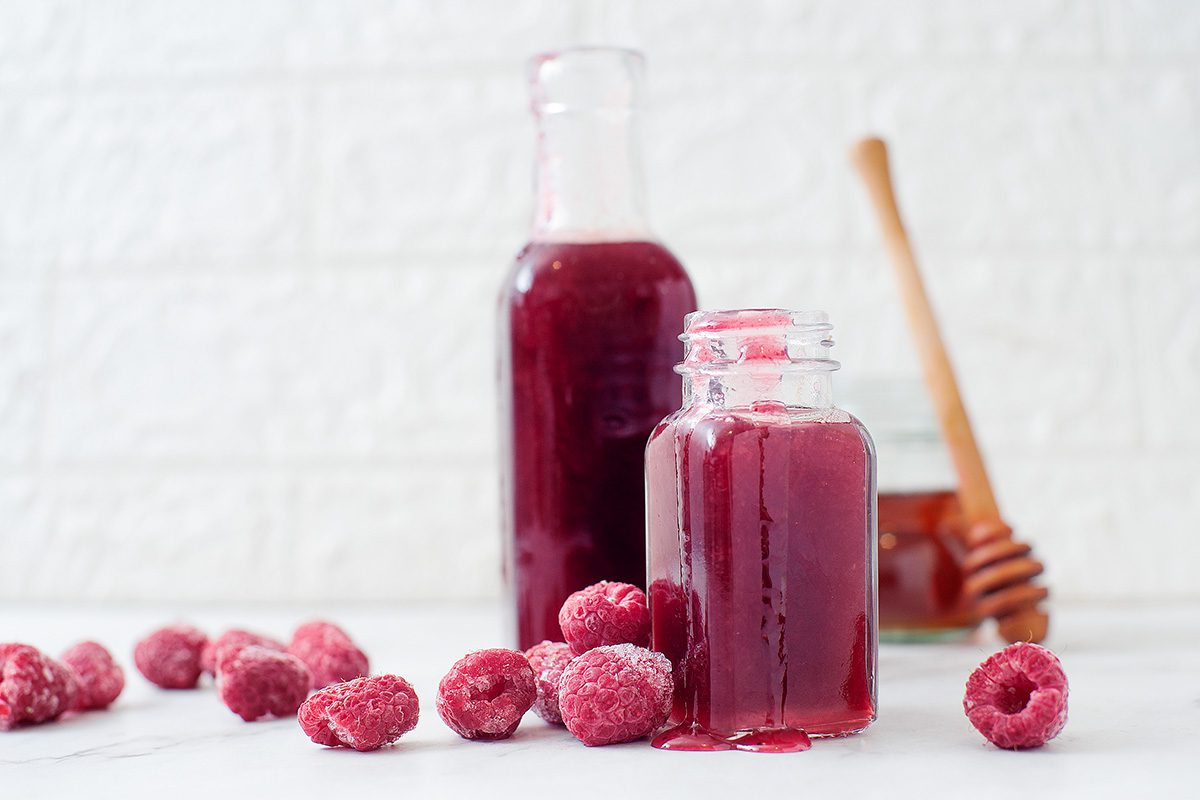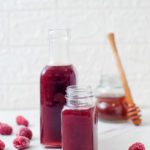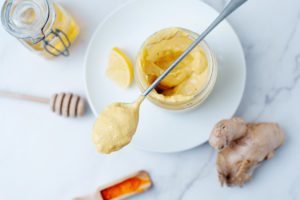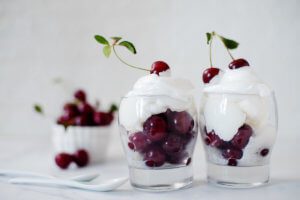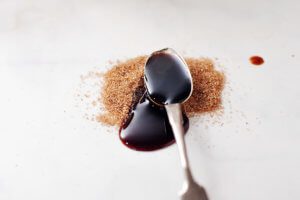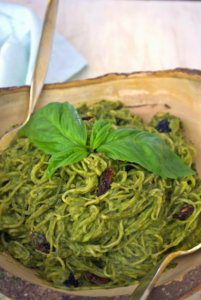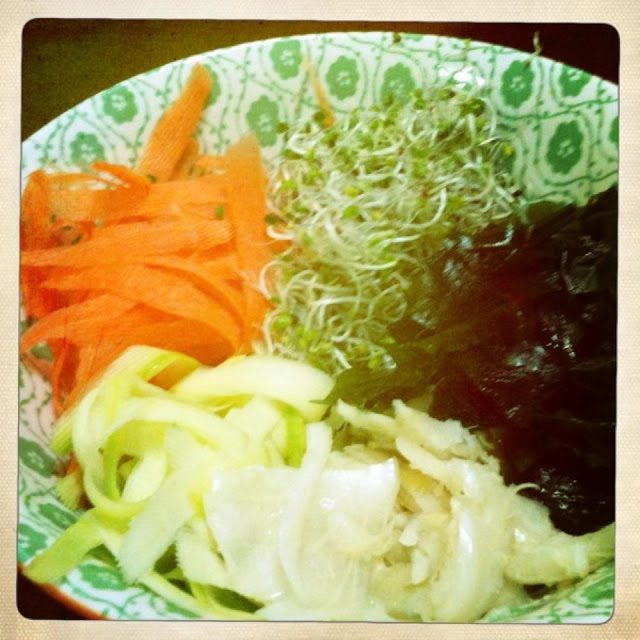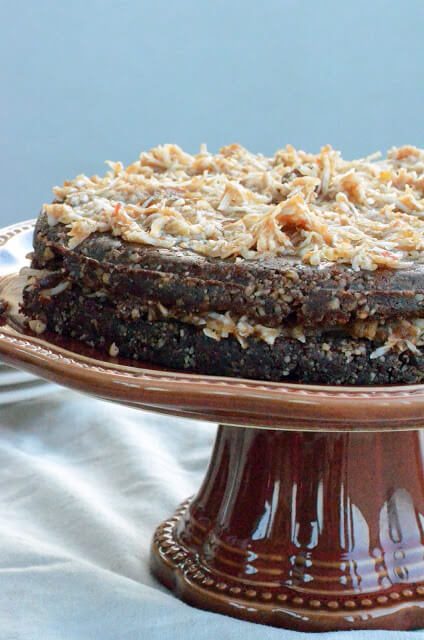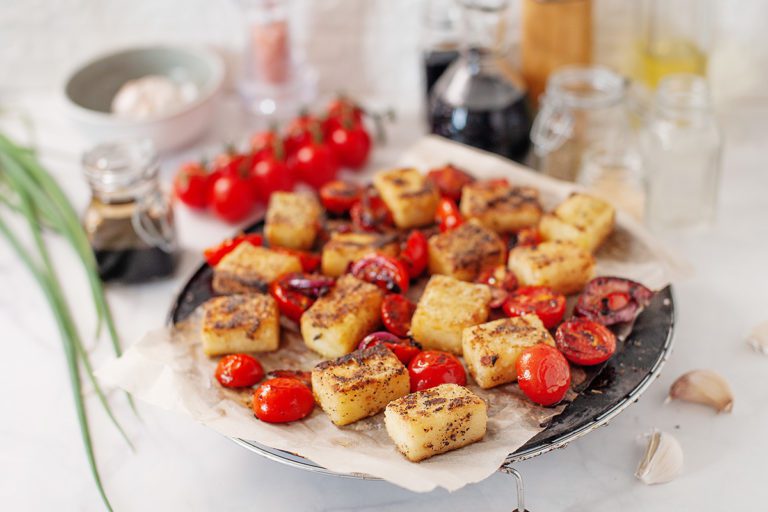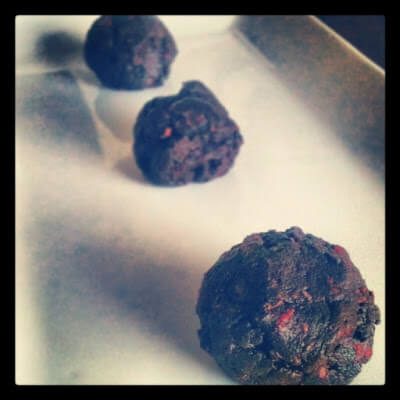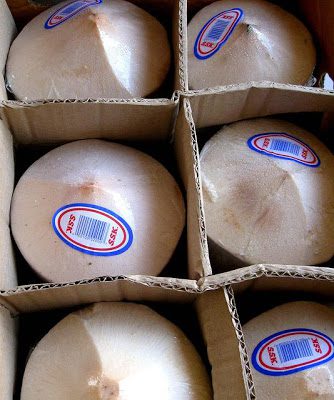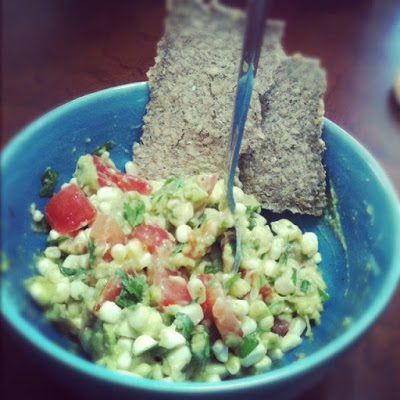Have you ever found yourself captivated by the vibrant color and tantalizing aroma of a raspberry? Now, imagine capturing that essence in a liquid form.
That, my friends, is the magic of raspberry syrup.
This delightful concoction is a concentrated form of all the goodness raspberries have to offer, simmered down into a sweet, tangy, and incredibly versatile syrup. Before I get into how to make raspberry syrup, let me go through some basic details to appease the search engine gods.
What is Raspberry Syrup?
Raspberry syrup, a delightful concoction that captures the essence of raspberries in a liquid form, is typically made from fresh raspberries, sugar, and water. This sweet and tangy syrup, known for its vibrant color and tantalizing aroma, originated in Europe where raspberries have been cultivated for consumption since the Middle Ages.
The syrup was traditionally used to preserve the flavor of raspberries for use in the colder months, and over time, it has become a popular addition to a variety of dishes and beverages around the world.
Raspberry syrup is not just about its delightful taste, it’s also about its versatility. It’s like a little secret ingredient that can transform your kitchen experiments. From drizzling over your morning pancakes, adding a splash to your lemonade, to giving your cocktails a fruity twist, raspberry syrup is a true game-changer.
And let’s not forget about its role in desserts! A little drizzle over your vanilla ice cream or a dollop in your fruit salad can elevate your sweet treats to a whole new level.
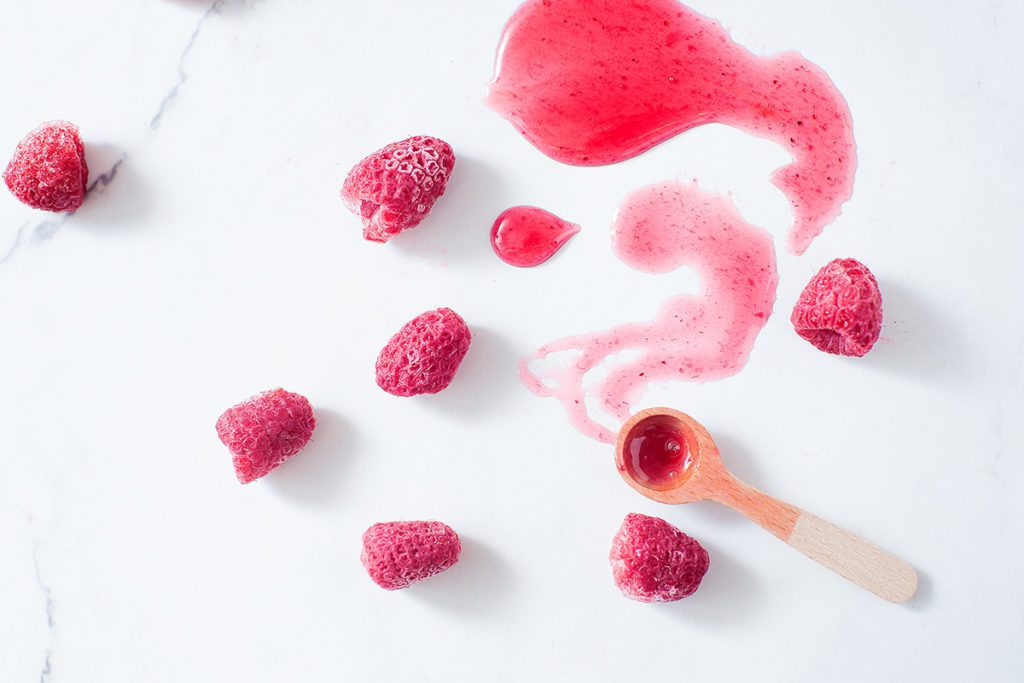

Why Make Raspberry Syrup at Home?
In our journey towards a more natural and conscious lifestyle, we often find ourselves questioning the ingredients and processes behind the products we consume daily. Raspberry syrup is no exception. While store-bought versions may offer convenience, they often come with a list of additives and preservatives that can be avoided when you choose to make your own at home.
Creating your own homemade raspberry syrup not only gives you control over what goes into your body, but it also allows you to connect with the process, adding a touch of personal love and care that no store-bought product can match. It’s a simple and rewarding task that requires just a few ingredients and a little bit of your time.
Homemade raspberry syrup can also be a ✨delightful✨ expression of your commitment to a healthier and more sustainable lifestyle. It’s a small but meaningful step towards reducing waste and unnecessary packaging, aligning with our ethos of living more harmoniously with nature. So why not give it a try? The taste of homemade raspberry syrup, fresh and free from artificial additives, might surprise you with its pure, vibrant flavor.
Raspberry Simple Syrup Ingredients
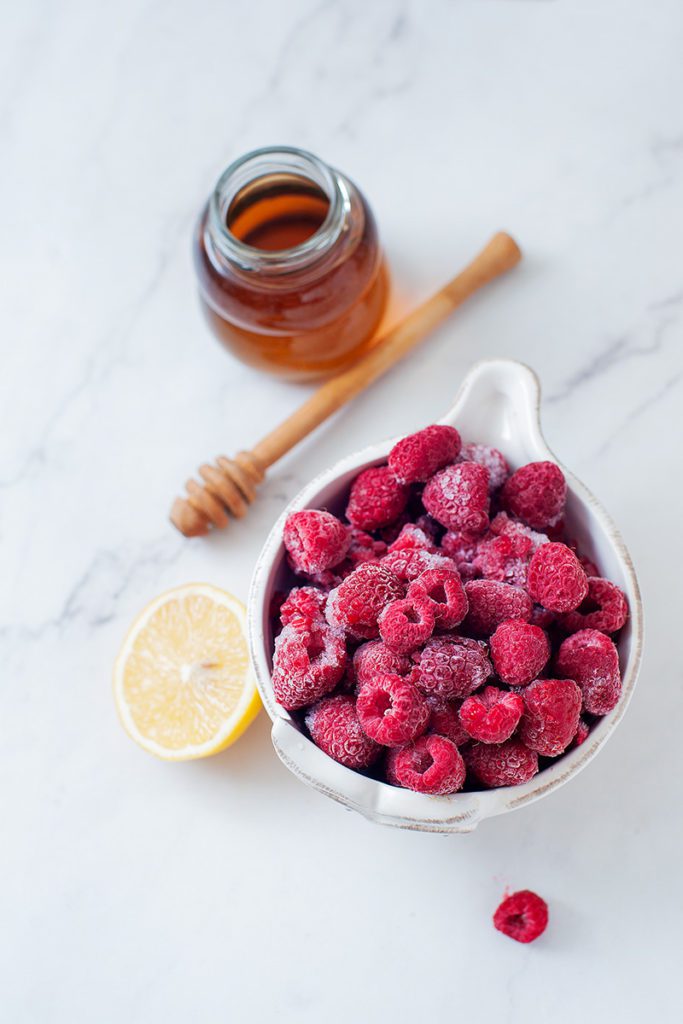

- 4 cups frozen raspberries
- 1/2 cup raw honey
- 1 tsp lemon juice
First, we have our star ingredient for raspberry simple syrup: 4 cups of frozen raspberries. Frozen raspberries are a wonderful choice as they are picked and frozen at their peak ripeness, ensuring that your syrup will have the most vibrant flavor possible. Plus, they’re readily available year-round, so you can enjoy this syrup no matter the season.
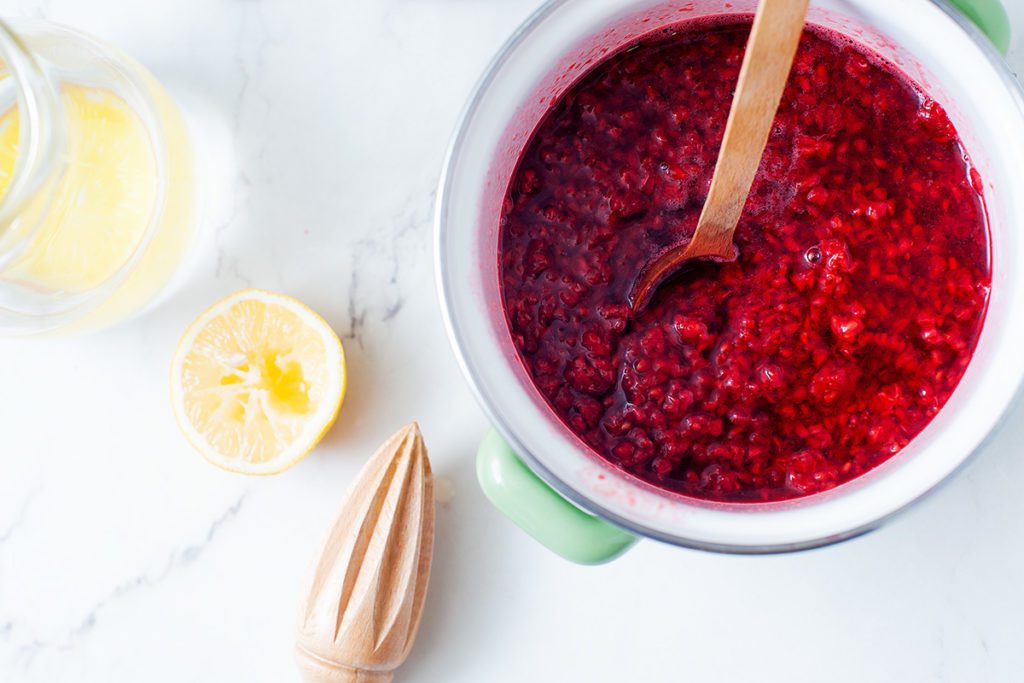

But if you can get your hands on some fresh berries, then give those a try instead. Fresh fruit syrup tastes soooooo good 🤤 If not, then frozen berries will do just fine.
Next, we sweeten things up with 1/2 cup of honey. Honey not only provides sweetness but also adds a depth of flavor that plain sugar simply can’t match. Plus, it’s a natural and healthier alternative to refined sugar. If you’re vegan, feel free to substitute with your favorite plant-based sweetener.
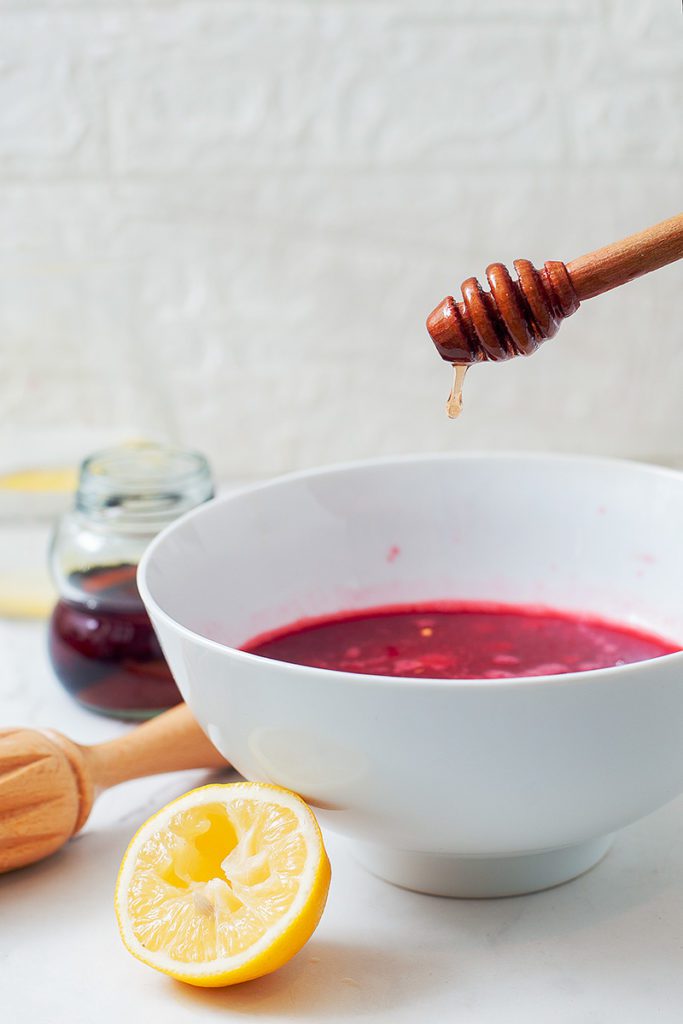

Lastly, we’ll add 1 tsp of lemon juice. This might seem like a minor player, but the lemon juice enhances the raspberries’ flavor and adds a hint of freshness to the syrup. It also helps to balance out the sweetness of the honey.
How to Make Raspberry Syrup: Step-by-Step Guide
To make this recipe, start by gathering your own fresh or frozen raspberries, and placing them in a small saucepan along with ½ cup of water. Turn up to medium high heat and let the magic begin, stirring occasionally to prevent it from burning. As the mixture comes to a boil, lower the heat, cover the saucepan, and let it simmer for about 5 minutes. This process allows the raspberries to release their vibrant color and rich flavors, creating a beautiful base for your syrup.
Next, it’s time to get a little messy. Mash the raspberry mixture to extract every bit of sweet raspberry flavor out. I like using a potato masher here! Remove from heat and then strain it through a fine mesh sieve to remove the seeds and pulp, leaving you with a smooth and luscious liquid.
Now, add in the honey. This natural sweetener not only adds sweetness but also gives the syrup a velvety texture. Bring the mixture back to a boil, stirring to ensure the honey is fully incorporated. If you’re using granulated sugar, then let the sugar dissolve before moving onto the next step.
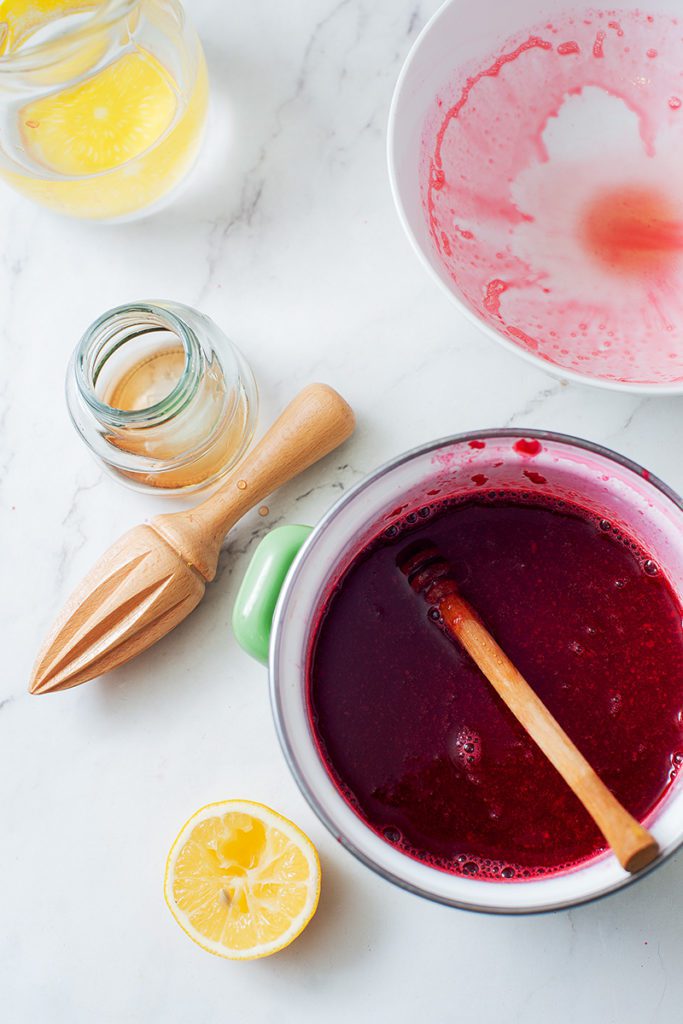

Finally, set your fresh raspberry syrup aside to cool. Once it’s reached room temperature, pour it into a bottle. You should end up with about 1 1/2 cups of homemade raspberry syrup, ready to add a burst of flavor to your drinks, desserts, and more.
Homemade Raspberry Syrup
Ingredients
- 4 cups frozen raspberries
- 1/2 cup raw honey
- 1 tsp lemon juice
Instructions
- Place frozen raspberries and ½ cup water in a saucepan. Bring to a boil, cover, and simmer for 5 minutes.
- Mash and strain berry mixture through fine mesh sieve.
- Stir in honey, and return to a boil.
- Set aside to cool and pour into a bottle, you should have about 1 1/2 cups.
Tips for Making the Best Raspberry Syrup
Creating your own raspberry syrup at home is not just about following a recipe. It’s about embracing the process, understanding the ingredients, and adding your own touch of love to the mix. Here are a few tips to help you make the most out of your raspberry syrup adventure:
- Quality Matters: Start with fresh, ripe raspberries for the best flavor. The quality of your ingredients will directly impact the taste of your syrup. Remember, nature has provided us with these beautiful berries, let’s honor them by choosing the best!
- Patience is Key: Don’t rush the process. Allow the raspberries to simmer gently and release their juices slowly. This will help to extract the maximum flavor and give your syrup a rich, deep color.
- Strain with Care: When straining the mixture, be gentle. You want to collect all the syrup but leave behind the seeds and pulp. A fine-mesh strainer or cheesecloth works best for this.
- Sweeten to Taste: Remember, you’re in control of the sweetness. Start with a little sugar, taste, and add more if needed. You can also experiment with different sweeteners like honey or agave nectar for a unique twist.
- Preserve Properly: Store this sweet syrup in a clean, airtight container in the refrigerator. It should keep for about two weeks. But trust me, it’s so delicious, it probably won’t last that long!
- Adjust Consistency: To make your raspberry syrup thicker, you can simmer it for a longer period, allowing more water to evaporate and the syrup to reduce. Conversely, for a runnier consistency, reduce the simmering time or add a bit more water or lemon juice. Adjusting the consistency of your syrup can help cater to different uses – a thicker syrup is great for drizzling over desserts or pancakes, while a thinner syrup might be preferred for beverages or as a light glaze for fresh fruits.
Remember, the joy is in the journey as much as it is in the destination. So, take your time, enjoy the process, and before you know it, you’ll have a bottle of homemade raspberry syrup that’s not just tasty, but also filled with your love and care.
Alternative Sweeteners That You Can Use
Granulated sugar is traditionally used when making simple syrup, but you can make your raspberry simple syrup recipe with whatever sweetener you prefer, honestly. I quite like honey because of its texture and flowery flavor, but I also use maple syrup a lot too.
- Maple Syrup: A delightful alternative to honey, maple syrup adds a unique, earthy sweetness to your raspberry syrup. It’s a natural sweetener that’s not only delicious but also packed with antioxidants. To use maple syrup in your recipe, simply replace the honey with an equal amount of maple syrup.
- Agave Nectar: Agave nectar is a sweetener harvested from the agave plant. It’s sweeter than honey, so you’ll need less of it. Start with a third of a cup and adjust to taste. Keep in mind that agave nectar has a more neutral flavor, so it might not add as much depth to your raspberry syrup.
- Coconut Sugar: Coconut sugar has a lower glycemic index than regular sugar, making it a healthier option. It adds a rich, caramel-like sweetness to your raspberry syrup. However, it’s granulated, so you’ll need to ensure it fully dissolves during cooking. Replace the honey with half a cup of coconut sugar.
- Date Syrup: Date syrup is a natural sweetener with a deep, fruity flavor that complements the raspberries beautifully. It’s less sweet than honey, so you might need to add a bit more. Start with 2/3 of a cup and adjust to taste.
Remember, when you’re experimenting with these alternatives, the key is to start with a smaller amount and adjust according to your taste. Enjoy the process and have fun creating your unique version of raspberry syrup!
Common Questions About Making Raspberry Syrup
In our journey to embrace the natural and raw lifestyle, questions are our best friends. They lead us to knowledge, and knowledge is power, right? So, let’s dive into some common queries about raspberry syrup.
What is raspberry syrup made from?
Raspberry syrup, in its purest form, is a delightful concoction made from fresh raspberries, sugar, and water. It’s as simple as that! The magic happens when these ingredients are simmered together, and the essence of berry flavor from the raspberries infuses into the syrup. The result? A vibrant, sweet, and tangy syrup that’s bursting with the goodness of raspberries.
Should raspberry syrup be refrigerated?
Absolutely! It’s best to store raspberry simple syrup in the refrigerator. This will help preserve its freshness and extend its shelf life. Remember, we’re working with natural ingredients here, and they don’t contain the preservatives that store-bought versions might. So, pop your homemade raspberry simple syrup in the fridge, and it should stay fresh for up to two weeks. Just make sure to use a clean, airtight container for storage.
Can I use frozen raspberries to make raspberry syrup?
Yes, you absolutely can use fresh or frozen here! If fresh raspberries aren’t in season or readily available, frozen berries are a fantastic alternative. They’re picked and frozen at peak ripeness, which means they’re packed with flavor. Just remember to account for the extra liquid that will come from the frozen berries as they thaw and cook.
How can I use raspberry syrup?
The beauty of raspberry syrup is its versatility. Drizzle it over pancakes or waffles for a fruity twist on breakfast. Stir it into yogurt or oatmeal. Use it as a sweetener in your favorite cocktail or lemonade. You can even use it as a glaze for desserts or a marinade for meats. The possibilities are endless!
Can I make raspberry syrup without sugar?
Yes, you can! If you’re watching your sugar intake, you can make raspberry syrup with alternatives like honey, agave nectar, or stevia. Keep in mind that each sweetener will bring its own unique flavor profile to the syrup, so choose one that complements the tartness of the raspberries.
How long does homemade raspberry syrup last?
When stored properly in the refrigerator, homemade raspberry syrup can last up to two weeks. If you want to extend its shelf life, you can freeze it. Just pour the cooled syrup into ice cube trays, freeze, and then transfer the cubes to a freezer-safe bag or container. You can then thaw individual cubes as needed.
Ways to Use Homemade Raspberry Syrup
Homemade raspberry syrup is not just a sweet treat, it’s a versatile addition to your culinary repertoire. Imagine drizzling this vibrant, fruity syrup over a stack of fluffy pancakes on a lazy Sunday morning. Or stirring it into a glass of sparkling water for a refreshing and guilt-free beverage on a hot summer day. It’s also great for flavoring iced tea 🤤 It’s even better for mixing cocktails, or just club soda if you’re alcohol free.
But the magic of raspberry syrup doesn’t stop at breakfast or beverages. It’s also a delightful companion to desserts. Try it over a scoop of vanilla ice cream, or use it to elevate a simple bowl of fresh fruit into a dessert worthy of a special occasion.
Here are a few of my recipes that this raspberry syrup would be perfect for:
- Golden Milk Mix: This healing golden milk mix could be enhanced with a drizzle of raspberry syrup. The tartness of the raspberry would complement the rich, earthy flavors of the golden milk.
- Vegan Banana Pancakes: Imagine drizzling raspberry syrup over these easy 3-ingredient vegan banana pancakes. The sweet and tart syrup would add a burst of flavor to the pancakes.
- Rosemary Citrus Tea: Adding raspberry syrup to this rosemary citrus tea could add a sweet and fruity twist. The raspberry flavor would pair well with the citrus and rosemary notes.
- Basic Overnight Oatmeal: A drizzle of raspberry syrup would add a sweet and fruity flavor to this basic overnight oatmeal, making it a delightful breakfast option.
- Vegan Ice Cream Cake: A drizzle of raspberry syrup over this creamy vegan ice cream cake would add a tangy contrast to the sweet and creamy flavors.
And for those of you who love to experiment in the kitchen, consider incorporating raspberry syrup into your savory dishes. It can add a surprising and delightful twist to salad dressings, marinades, or glazes for grilled meats. The possibilities are as limitless as your imagination. So go ahead, get creative with your homemade raspberry syrup recipe, and let it inspire your next culinary adventure.
Nutritional Facts of Raspberry Syrup
In the spirit of transparency and empowering you with knowledge about what goes into your body, let’s dive into the nutritional facts of our homemade raspberry syrup. This simple syrup is a delightful blend of frozen raspberries, honey, and a touch of lemon juice. It’s not just about the sweet and tangy flavor, but also about the nutrients these simple ingredients bring to your table.
Raspberries, the star of this recipe, are packed with vitamins, antioxidants, and fiber. A cup of raspberries contains about 65 calories, 1.5 grams of protein, 0.8 grams of fat, and 15 grams of carbohydrates, which includes 8 grams of dietary fiber. They are also rich in Vitamin C and manganese.
Honey, our natural sweetener, is a powerhouse of antioxidants and can provide a quick energy boost. A tablespoon of honey contains around 64 calories, 17 grams of carbohydrates, and numerous antioxidants.
Lemon juice, while used sparingly, contributes its own share of Vitamin C and enhances the flavor of the syrup.
Here’s a simple breakdown per serving (1 tablespoon):
| Nutrient | Amount |
| Calories | 45 kcal |
| Carbohydrates | 11.5 g |
| Protein | 0.2 g |
| Fat | 0.1 g |
| Fiber | 0.8 g |
| Sugar | 10.5 g |
Remember, these values can vary depending on the exact quantities and brands of ingredients you use. But one thing is for sure: this homemade raspberry syrup is a healthier alternative to store-bought versions, free from artificial preservatives and sweeteners. Plus, it’s made with love, and that’s the best ingredient of all!
Closing thoughts
Remember, the joy of making your own raspberry syrup is in the journey as much as the destination. So, have fun with it, experiment, and enjoy the fruits (pun intended) of your labor!
